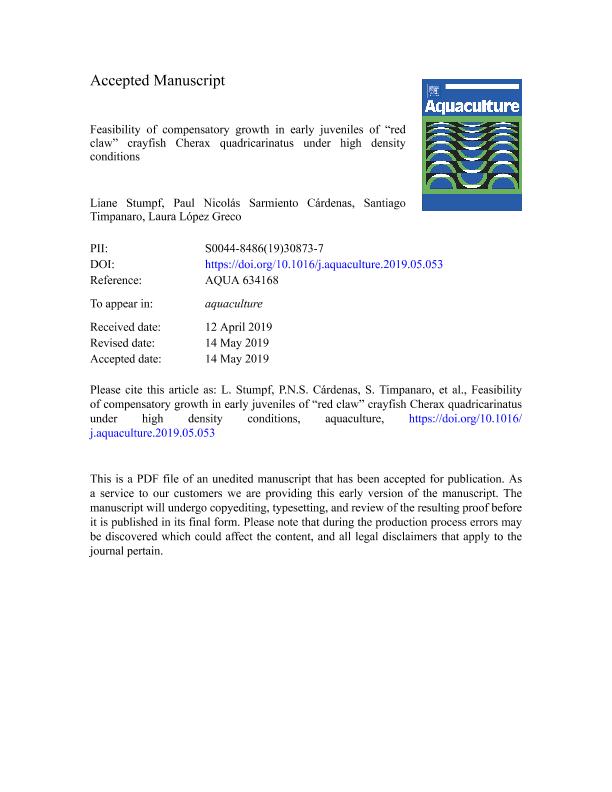Mostrar el registro sencillo del ítem
dc.contributor.author
Stumpf, Liane

dc.contributor.author
Sarmiento Cárdenas, Paul Nicolás
dc.contributor.author
Timpanaro, Santiago
dc.contributor.author
Lopez, Laura Susana

dc.date.available
2021-09-03T02:10:51Z
dc.date.issued
2019-06
dc.identifier.citation
Stumpf, Liane; Sarmiento Cárdenas, Paul Nicolás; Timpanaro, Santiago; Lopez, Laura Susana; Feasibility of compensatory growth in early juveniles of "red claw" crayfish Cherax quadricarinatus under high density conditions; Elsevier Science; Aquaculture; 510; 6-2019; 302-310
dc.identifier.issn
0044-8486
dc.identifier.uri
http://hdl.handle.net/11336/139580
dc.description.abstract
The aim of this work is to study the feasibility to induce compensatory growth in Cherax quaricarinatus crayfish at an early stage of development under high density, the typical conditions of nursery phase. An advantageous characteristic of this species is the capacity to face temporary starvation, especially at early stages of development. This would help to design feeding strategies avoiding overfeeding, and diminishing operating costs in aquaculture. In this sense, during the last 8 years it was analyzed in this species the application of intermittent feeding, known as unfavorable feeding condition followed by daily feeding (favorable feeding condition). This alternative feeding protocol was used in the present study to trigger compensatory growth. Juveniles weighing 0.07 ± 0.01 g were distributed in 2 feeding regimes: C (control): juveniles fed daily during 60 days, and IF (intermittent feeding): juveniles deprived of food for 4 days and then fed for the following 4 days, these 4 days’ cycles were repeated during the first 20 days, on day 21 they were daily fed until day 60. Juveniles were stocked in each tank under 0.0096 crayfish/cm2 density, and zootechnical and biochemical parameters were evaluated throughout 60 days. A very suitable and similar survival (~ 65%) was maintained between feeding regimes, and the previously unfavorable feeding condition did not promote greater aggression among juveniles. There was a small compensatory response, but no recovery occurred probably because the favorable feeding condition was too short to trigger a strong compensatory response. Hyperphagia and improvement of feed conversion were not observed in juveniles of IF, suggesting that the high density was the key for these primary compensatory mechanisms to be absent. The competition for food, could have affected and changed the priority in allocating energy resources for accelerated growth. Lipids and glycogen content from body mass were strongly depleted after unfavorable feeding condition, but there was almost a 100% recovery during favorable feeding condition. We suggest that this response was detrimental to body mass as a priority and as a strategy for juveniles to extend survival during the ‘double’ nutritional stress caused by intermittent feeding and high density. The applicability of this alternative feeding strategy during an intensive production system can be viable, however, some changes must be considered in order to trigger compensatory growth. We suggest that a long-term of the favorable feeding condition could trigger a strong compensatory response if the high density tested in the study is maintained. We believe that juveniles of the current study had to face two nutritionally stressful factors: food restriction and high density. This could change the priority in allocation of energetic reserves and then the other suggestion would be to reduce the density if the same alternative feeding protocol is maintained.
dc.format
application/pdf
dc.language.iso
eng
dc.publisher
Elsevier Science

dc.rights
info:eu-repo/semantics/openAccess
dc.rights.uri
https://creativecommons.org/licenses/by-nc-sa/2.5/ar/
dc.subject
Nutritional resistance
dc.subject
Intermittent feeding
dc.subject
Compensatory growth
dc.subject
Nursery
dc.subject
High density
dc.subject
Cherax quadricarinatus
dc.subject.classification
Otros Tópicos Biológicos

dc.subject.classification
Ciencias Biológicas

dc.subject.classification
CIENCIAS NATURALES Y EXACTAS

dc.title
Feasibility of compensatory growth in early juveniles of "red claw" crayfish Cherax quadricarinatus under high density conditions
dc.type
info:eu-repo/semantics/article
dc.type
info:ar-repo/semantics/artículo
dc.type
info:eu-repo/semantics/publishedVersion
dc.date.updated
2020-11-20T14:42:35Z
dc.journal.volume
510
dc.journal.pagination
302-310
dc.journal.pais
Países Bajos

dc.journal.ciudad
Amsterdam
dc.description.fil
Fil: Stumpf, Liane. Consejo Nacional de Investigaciones Científicas y Técnicas. Oficina de Coordinación Administrativa Ciudad Universitaria. Instituto de Biodiversidad y Biología Experimental y Aplicada. Universidad de Buenos Aires. Facultad de Ciencias Exactas y Naturales. Instituto de Biodiversidad y Biología Experimental y Aplicada; Argentina
dc.description.fil
Fil: Sarmiento Cárdenas, Paul Nicolás. Universidad Nacional de Colombia; Colombia
dc.description.fil
Fil: Timpanaro, Santiago. Consejo Nacional de Investigaciones Científicas y Técnicas. Oficina de Coordinación Administrativa Ciudad Universitaria. Instituto de Biodiversidad y Biología Experimental y Aplicada. Universidad de Buenos Aires. Facultad de Ciencias Exactas y Naturales. Instituto de Biodiversidad y Biología Experimental y Aplicada; Argentina
dc.description.fil
Fil: Lopez, Laura Susana. Consejo Nacional de Investigaciones Científicas y Técnicas. Oficina de Coordinación Administrativa Ciudad Universitaria. Instituto de Biodiversidad y Biología Experimental y Aplicada. Universidad de Buenos Aires. Facultad de Ciencias Exactas y Naturales. Instituto de Biodiversidad y Biología Experimental y Aplicada; Argentina
dc.journal.title
Aquaculture

dc.relation.alternativeid
info:eu-repo/semantics/altIdentifier/doi/http://dx.doi.org/10.1016/j.aquaculture.2019.05.053
dc.relation.alternativeid
info:eu-repo/semantics/altIdentifier/url/https://www.sciencedirect.com/science/article/abs/pii/S0044848619308737
Archivos asociados
